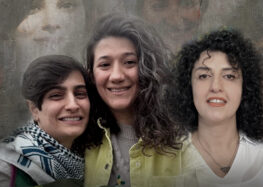The Emergence of Vigilante Groups
The designation of the Basij as the principal enforcers of the Plan to Promote Virtue and Prevent Vice formalized the role of vigilante groups that had in fact already become active in the run-up to the legislation. Indeed, the movement to propel rigid public enforcement of strictly conservative notions of Islamic female piety has long been led by a vigilante group—the militant Islamic group Ansar-e Hezbollah (or Nation of Hezbollah).
Semi-official in that it is protected by senior officials and clerics of the Islamic Republic, Ansar-e Hezbollah is not formally part of the state apparatus. It has a history of violent enforcement of hardline ideological predilections, especially against peaceful protesters (as in the 1999 student protests and the 2009 post-presidential election protests) and against women whom it considers to be in violation of Islamic female dress codes. After Rouhani’s election, there were fears that they would reappear, just as they had during the (1997-2005) era known as the reformist period under then-President Khatami, when hardliners felt they had to re-assert themselves.
Early in 2014, prior to the onset of these legislative initiatives and public statements, Ya Lesarat, the official Ansar-e Hezbollah publication, issued a statement in April that indicated the group was gearing up to re-assert conservative values:
“The Nation of Hezbollah is practicing a period of patience. However, since the Supreme Leader has stressed that revolutionary forces who object to the current situation should be present in this battlefield, other volunteer groups have formed to make up for the silence that has been imposed on us.”
A few days later, on April 29, Mojtaba Rahmandoost, the MP who drafted the Promotion of Virtue bill, delivered a speech during a weekly Ansar-e Hezbollah meeting, that reflected the group’s role in pushing forward legislation on the issue. Rahmandoost stressed,
“Promoting virtue and preventing vice should become a more popular practice. When have we seen people come to the streets (to protest) problems with (lack) of chastity and hijab? I’m not denying the responsibility of the government. Officials too must do their duty. I do not wish to talk about what I have done, but recently at Parliament’s Social Affairs Committee, we formed a chastity and hijab commission and invited the Ministry of Interior, Ministry of Welfare, and Chastity and Hijab Foundation to participate. We are about to take some steps but they won’t be enough to solve the problem.”
Indicating growing public confidence, Ansar-e Hezbollah sent its forces onto the streets, to Fatemi Square in Tehran, on May 7, 2014, in the group’s first demonstration against women’s alleged non-conformity with hijab. The protesters did not have a permit, a requirement in practice in Iran, but it was held nonetheless. ANA news agency reported, “Even though Tehran Governor’s Office announced that they had not issued a permit for a demonstration in front of the Ministry of Interior, more than a thousand people gathered in the west wing of Fatemi Square and chanted slogans. Later, the protesters began walking towards Vali Asr Square.” The report added, “The presence of police was unnoticeable. However, Hossein Allah-Karam, a member of the group known as Ansar-e Hezbollah was present and talked to Tehran Police Chief Sajedinia.” According to ANA, some of the chants included, “Men! Where is your wife’s hijab? And Men! Where is your manhood?”
The Judiciary’s spokesperson, Gholamhossein Mohseni Ejei, publicly defended the protest, stating on May 19, “We have to ask whether the Judiciary, the police, the Ministry of Guidance, and other bodies have been successful in this regard or not? Has the prosecutor, as the public defender, been able to act to protect the hijab in every province? If we respond (properly) to these kinds of concerns, there will be no need for people to demonstrate.”
On May 20, 2014, Ansar-e Hezbollah’s website asserted, “We must stress that the era of ineffective protests are over; the kind of protests that only further provoked our enemies and norm-breakers. What is needed now is for Hezbollah to enter this fight and directly deal with these violators.”
That month on its official website the group issued a statement titled, “Hezbollah’s Countdown for Ending Nudity and Lack of Hijab” which asserted: “(Hezbollah forces) have come to warn that they are preparing for a widespread operation to end nudity and lack of hijab. We are issuing this warning due to the fact that the problem of (lack of conformity with) the hijab in public places has become worse and anti-revolutionaries have intensified their recent operation to officially get rid of the hijab.”
On July 3, 2014, Ansar-e Hezbollah reported that it had begun taking action. The group’s official website stated, “On June 22, the first motorcycle patrol unit for promoting virtue and preventing vice [was] dispatched to the streets of Tehran.”
After the announcement, Ansar-e Hezbollah’s motorcycle patrol units were heavily reported on in the Iranian press. Ministry of Interior officials, who report directly to Rouhani, warned that the group must apply for legal permits before taking any action, but Ansar-e Hezbollah replied that they “see no reason to apply for a permit (from the Ministry of Interior) for the possibility of engaging in promoting virtue and preventing vice.” The group added, “Our dear brothers in the police forces have been informed and we will continue to cooperate with them.”
On June 24, 2014, even as Interior Ministry officials demanded that these groups stop their lawless actions, Hezbollah’s operational commander was quoted on the group’s website stating that the motorcycle patrols would continue. “Thirty-five years since the Islamic Revolution, the people who do not comply with proper hijab consider nudity and corruption as civil rights. They see devout Muslims’ demand for conformity with Islamic and legal requirements as an intrusion in their privacy.” He stressed, “The current unrestrained situation of nudity and lack of conformity with hijab is the direct result of Hezbollah’s weak presence on the scene.”
Re-asserting the long touted connection between improper hijab and enemies of the state, Hojjatoleslam Ghaem-Maghami, a cleric associated with Ansar-e Hezbollah, delivered a speech at an Ansar-e Hezbollah meeting on September 13, 2014, in which he stated, “When a woman does not comply with the hijab, even though it would be a sin, she could do so in her own home. But why does she insist on her non-conformity in public? The answer is very clear. They are promoting a way of thinking. When the people show their opposition to religion and tradition through their manners and behavior, they want to say society belongs to them and even the government should belong to them.”
On September 30, 2014, Hojjatoleslam Seyed Morteza Hosseini, a Member of Parliament’s Social Affairs Committee, said to Ansar-e Hezbollah members in their weekly meeting, “The Supreme Leader talked about some important issues during a speech last year for the Supreme Cultural Revolution Council. The Supreme Leader said, ‘I am sincerely concerned about our cultural problems. I’m truly worried. These are the kind of concerns that could wake a person up in the middle of the night and lead him to plead to God. I have these concerns but I cannot talk about them publicly. One of my fears is that the enemy has attacked our youths’ faith.’” Morteza Hosseini added, “The Supreme Leader does not believe we should go to the gatherings of bums and trash to promote virtue and prevent vice. Such an act would be a threat to your life. Promoting virtue is a duty. Even if some don’t comply with their duty, others are still responsible. Once a reporter told me Ansar-e Hezbollah is trying to act in a collective way to promote virtue and prevent vice. I responded that, ‘Ansar-e Hezbollah is doing its religious duty within a legal framework, which is nothing new.”
A few days later, on October 7, 2014, Parliament agreed to vote on the Plan to Promote Virtue and Prevent Vice.
Thus the national discussion regarding the need to implement a “promotion of virtue” and “prevention of vice” initiative seems to have been propelled forward largely by Ansar-e Hezbollah. Parliament, hardline clerics, and others in the conservative establishment effectively played catch up, transforming directives by this shadowy, unofficial group into state policy through Parliamentary legislation and official public pronouncements.
The explicit designation of the Basij as the enforcers of the Plan to Promote Virtue is testament to the role of Ansar-e Hezbollah. It is critical to understand that Ansar-e Hezbollah and the Basij militias are, for all intents and purposes, the same. Ansar-e Hezbollah may be unofficial, and the Basij the official paramilitary force of the Revolutionary Guards, but the members of the two groups are largely the same, and Ansar-e Hezbollah is controlled by former and current Basij members. Thus the Promotion of Virtue Plan’s designation of the Basij as the principal enforcers of the Plan not only ensured implementation of Ansar-e Hezbollah’s policies, it also ensured that their own members, through the Basij militia, would be the officially legitimized and state-sanctioned vehicles of enforcement. The acid attacks against the young women in Isfahan are the harvest of such policies.




